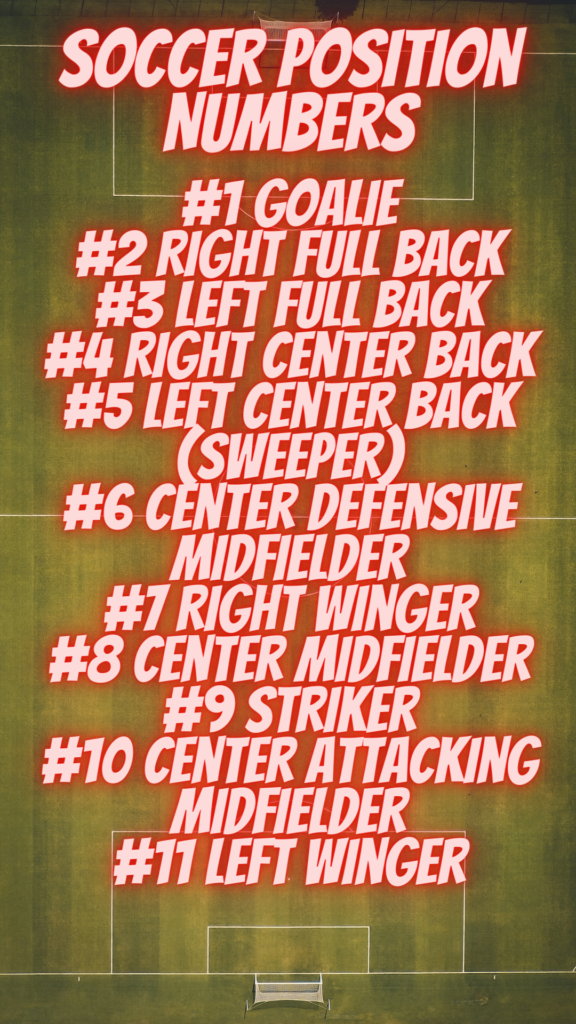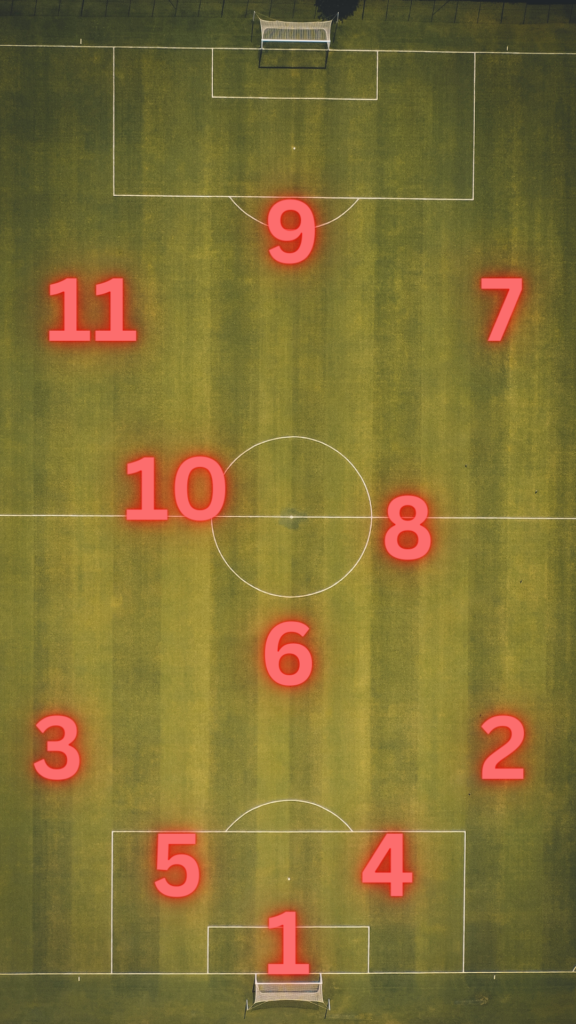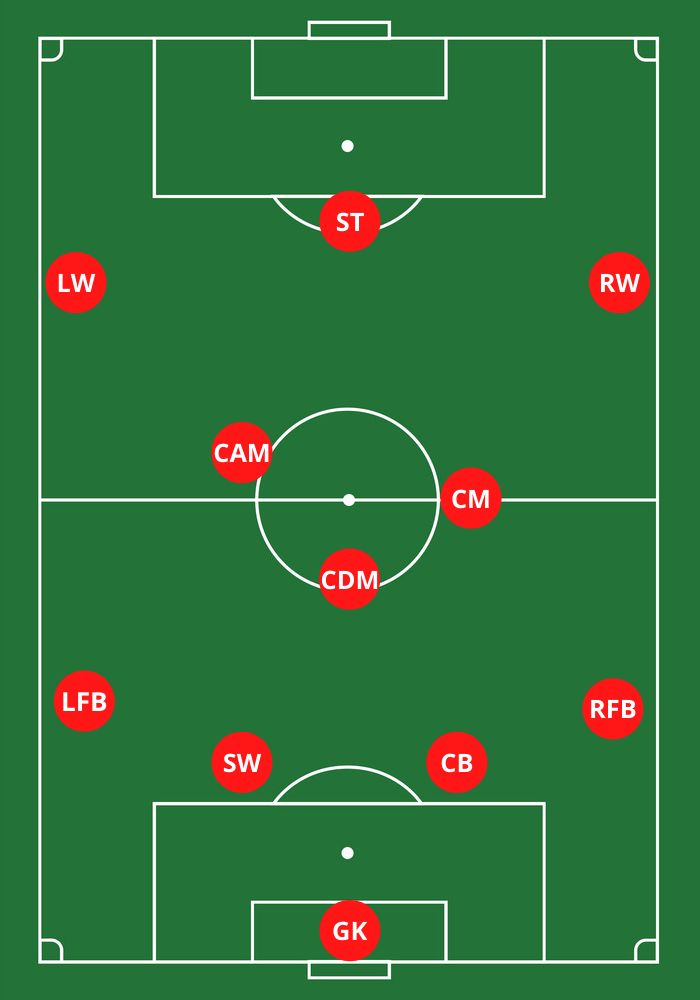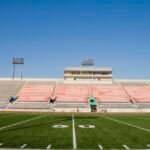Soccer Position Numbers Explained
- Author - Andy Long
- Last Updated -
Soccer Position Numbers – What is the meaning?
Understanding Soccer Position Numbers
Whether you’re a soccer coach, an avid fan, or an active player, understanding the meaning behind soccer position numbers is key to appreciating the game’s structure. These numbers aren’t just random—they represent the roles and responsibilities of each player on the field.
Traditionally, the goalkeeper is synonymous with the number 1 jersey, while the rest of the team is numbered from 2 to 11 based on their positions. This system reflects the team’s formation, with defenders typically wearing lower numbers and forwards donning higher ones. For example, central defenders often wear 4 or 5, while strikers are known for iconic numbers like 9 and 10.
However, variations in numbering can occur due to team traditions or individual player preferences. Understanding this numbering system not only helps fans follow the action but also enables coaches to organize their teams more effectively, ensuring each player thrives in their assigned role.


soccer position numbers quick guide
Soccer, the world’s most popular sport, is a game of strategy, skill, and teamwork. Each player on the field plays a crucial role, and understanding these roles is key to appreciating the beautiful game. That’s why we have created this “Soccer Positions Quick Guide” for you.
From the goalkeeper, the last line of defense, to the striker, the primary goal scorer, every position has unique responsibilities and challenges. The traditional numbering system assigned to these positions provides a universal language for discussing strategy and tactics.
Whether you’re a seasoned fan, a budding player, or a newcomer to the sport, this quick guide to soccer positions and their corresponding numbers will enhance your understanding and enjoyment of the game.
Let’s dive into the heart of soccer and explore the roles that make this sport a global phenomenon.

Goalkeeper (1):
The goalkeeper, also known as the “keeper”, is the last line of defense for their team. They are responsible for preventing the other team from scoring goals and are the only players allowed to use their hands on the field.
Right and Left Backs (2 & 3):
These players are known as the outside defenders. They defend the opposing team’s wide wingers and are also involved in offense sometimes, joining the offensive attack depending on which side of the field their team is attacking.
Sweeper and Central Back (4 & 5):
These are the central defenders, tasked with protecting the center of the field. They intercept passes, tackle attackers, block shots, and steal the ball in one-on-one situations.
Defensive Midfielder (6):
(CDM) This player’s main role is to slow down the opposition from attacking the middle of the field and gaining possession. They are also solid passers, playing a significant role in advancing the ball into the defense’s territory.
Wingers (7 & 11):
Positioned along the left and right touchlines of the field, wingers are responsible for creating scoring opportunities, pushing the ball up the field, and scoring themselves.
Central Midfielder (8):
Central midfielders are the link between defense and attack, with major responsibilities on both offense and defense. They often dictate the speed and pace of the game and are responsible for controlling the offense at times.
Striker (9):
Positioned deep in the opponent’s territory, strikers pose the biggest threat to the opposing team’s keeper. Their main objective is scoring goals.
Central Attacking Midfielder (10):
These are mainly offensive players, positioned between the forwards and center midfielders. They are often tasked with dribbling or passing the ball deep into their territory for a goal.

Each player on the field has an important job as it relates to the team’s overall success. Some players need to possess great one-on-one skills, some need elite stamina, and some need the ability to play with physicality.
It’s the coordination of all the players that makes soccer so much fun to watch.
Soccer Positions Explained in Detail
The familiar system of soccer position numbers we recognize today traces its roots back to 1939, when the English football governing body introduced it. However, its inception can be traced even further back to 1928 when Herbert Chapman, the renowned manager of Arsenal, pioneered the use of numbered shirts in a match against Sheffield.
The concept was simple yet revolutionary: by assigning numbers to players, it enhanced their awareness of their positions on the field and facilitated better teamwork. This innovation laid the foundation for the iconic 1-11 numbering system, a tradition still embraced by many international teams.
The evolution of the numbering system continued with the introduction of substitutes in 1965. These substitutes were assigned ascending numbers from 12 onwards. Interestingly, players harboring superstitions were given the option to decline wearing the supposedly unlucky No. 13 shirt.
Over the years, the soccer position numbers system has evolved and adapted, yet it remains an integral and enduring aspect of the beautiful game.”
So what are the soccer positions numbers? Let's Have A Look...
Soccer Positions By Number
11. Left Wing (or Wide Midfield)
10. Attacking Midfielder
9. Striker (or Center Forward)
8. Midfielder (or Box to Box Midfielder)
7. Right Winger (or Wide Midfield)
6. Defensive Midfielder (or Holding Midfielder)
5. Center Back (or Sweeper)
4. Center Back
3. Left Back
2. Right Back
1. Goal Keeper
Soccer Position #1: Goal Keeper
The primary role of a goalkeeper is to stop the opposing team from scoring. They use any part of their body possible to block shots from going into the goal. In most cases, a goalkeeper is responsible for taking goal-kicks/kick-outs (when the opposing team plays the ball out over the end-line).
The goalkeeper is the last line of defense and with the full field in view, the goalkeeper’s role in the organization and positioning of the outfield players is vital for success, they also keep the back line organized from their box with vocal commands.
The position often has an affiliation with being tall because they must be able to move laterally and jump high to block shots. Quick reflexes and great agility help too!
The goalie, or keeper, is one of the most important players on a football team. They are in charge of defending their goal and stopping any other teams from scoring by blocking shots with their hands (or bodies). Goalies need to be strong because they often have to jump high into the air when opponents launch an attack.
Position: Goalkeeper
- The most defensive position in soccer
- The main job is to stop opposition goals
- Also organizes the defense and builds play from the back
- Wears gloves, and a different colored jersey from teammates
- The only player who can use their hands in their 18-yard box (apart from throw-ins!)
There are four defensive soccer positions that can be in front of the goalkeeper:
center back, fullback, wingback, and sweeper. The job of these defenders is to ensure that the opponents do not score and keep them from turning their team’s offensive opportunities into a goal.
Soccer Position #2 – Right or Left Fullback
A full-back has some offensive responsibilities as well. The extent of these responsibilities depends on the player’s abilities the formation being played and the coach’s strategy. Full-backs provide support to the attack. They often make overlapping runs wide of the midfielders and supply crosses into the penalty box.
Most importantly, Fullbacks are the last line of defense for a team. Their job is to protect their side and help out with offensive plays as needed. They can play an as important role on both offense and defense.
Position: Full-back
- Lines up either side of the defense
- Marks opposition wingers
- Provides support for the wide midfielder ahead of them
- May overlap and send crosses into the opposition box
- Often takes throw-ins
Soccer Position #3 – Right or Left Wingback
A modern full-back must be quick, technical, tenacious, and physical. Strength is always important on the field, but in the Full Back positions, it’s more important to play smart and consistent.
A variation of this position is a “wing-back” (WB). Wing-Backs are used in formations where there are 3 center-backs. Consequently, in this formation, the full-back does not have as much of a defensive responsibility as normal.
Wingback players are the cornerstone of any soccer defense. They not only defend each play but also provide support for their teammates by running and blocking in open space to help set up scoring opportunities for other team members.
Wingbacks (LWB, RWB) have a vital role within every football squad because they’re responsible both defensively and offensively. As mentioned before, these versatile positions must be able to run all over the field as well as give aid when needed – this can make them more physically demanding than some other positions that may require less stamina or endurance
Position: Wing-back
- A modern variation of the full-back
- Overlaps and sends crosses into the opposition box
- Still marks opposition wingers when needed
- Expected to stay on their touchline
- One of the most physically demanding positions
Soccer Position #4 – Center Back (CB)
Modern Center Back’s are more skillful than those from traditional times. Most teams have a ‘build from the back’ philosophy – This starts at the youth coaching level. It’s important for CBs to be able to make effective passes and set up attacks. CBs don’t normally score from normal play, however, it is common for them to get in the box for scoring opportunities during corner and free kicks when they’re close to the box.
The CB has the most responsibility in terms of defensive plays such as: tackling, heading, and intercepting. The position is usually reserved for a tall player with good jumping abilities to head away shots on goal.
The center back is the rock of your team. They are positioned in the middle and act like a stopper for any opposition attacking from behind, enabling them to be effective at both defending and intercepting balls coming towards their goal.
The center back is the one player on defense that defenders count on to stop attacking players. This makes them a key component of success for any team.
‘center backs’ or CBs are an important part of any defensive lineup as they play right in front of the goal and need to be able not only block shots but also break up passes from opposing teams’ forwards trying their best to get a shot off near your own net!
Position: Centre-back (stopper)
- Shuts down opposition attackers
- May employ zonal or man-marking strategies
- Brings the ball out from the back
- Often tall and physically strong
- Bravery and heading ability are desirable, for use in either box
Soccer Position #5 – Sweeper (SW) Left Center Back
Another style of CB is a “sweeper”. The sweeper sits behind the defensive line, stopping through passes, interception the ball, and tackles. These days, goalkeepers often have the skills to take up some of the sweeper role.
- This soccer position is not as common these days. They have to be able to defend their own goal while also assisting the goalkeeper should any balls get past them into a dangerous area. They mostly are behind other defenders to help in an offensive play if necessary, but there are times when they have to step up and take charge themselves.
The 5th position or sweeper has been around since soccer’s inception centuries ago and although this role isn’t quite what it used to be thanks to modern technology like nets which were designed with protection from such blunders in mind, nevertheless still doing its job
Position: Centre-back (sweeper)
- A safety net for the stopper(s) alongside them
- Races to cover gaps when defense is breached
- Less concerned with man-marking
- Reads the game from deep
- Joins midfield build-up when in possession
Midfielders are the backbone of any successful team
They work tirelessly to keep the ball moving and help set up goals for their teammates, they’re always on call but seldom get recognition for it
Soccer players have specific positions that they are assigned to on the field, and midfielders are often responsible for maintaining a balance of attacking and defending. When it comes to assigning players to Soccer Position Numbers midfielders are probably the most critical to success.
For More Information on How to Play in The Midfield CLICK HERE
Soccer Position #6 – Center Defensive Midfielder (CDM) or Holding Midfield
Their role is to put in hard tackles, break up attacks, and manage the midfield from a defensive standpoint. A quality defensive midfielder is a difficult, specialized position.
Quality defensive MFs are some of the most sought-after players in the game today. They are smart, aware tactical players with a talent for reading the game.
Their primary roles are marking opponents, challenging tackling, intercepting the ball, and effective passing. Defensive MFs must play disciplined and have a very high soccer IQ.
Defensive Midfielders must be able to retrieve balls from all parts of the field and connect their team’s back line to its attacking front lines.
The midfield is the beating heart of any soccer team. It’s where your defenders and attackers meet, an intersection between offense and defense that can make or break a game depending on how you play it. The defensive midfielder has to be especially mindful because their job is so important: they have to ensure ball possession for themselves while setting up scoring opportunities for others.
Position: Defensive midfielder (ball-winner) (deep-lying playmaker)
- Sits in front of the defense
- Wins the ball back with tackles and interceptions
- Covers teammates when they go forward
- Harries opposition attackers
- Physically fit and tenacious
- Creative playmaker from deep
- Distributes to teammates, near and far
- Sets the team’s tempo
Soccer Position #7 – Right Winger (RW) Or Right Midfield
Right, and left midfielders are also known as wingers. They occupy space near either touch or sideline. For many teams, wingers play a significant role in their offensive gameplay. Wingers are usually quick and skilled with the ball at their feet.
They rely on their ability to beat a player 1 V 1 to give themselves opportunities to cross the ball or create a goalscoring chance.
A lot of wingers are quality strikers of the ball with the vision and ability to pick out their strikers with crosses or passes from wide areas. Great wide midfielders tend to chip in with their fair share of goals and assists.
These players play on the edges of the field, drawing out their opponents’ defense by making room for players in midfield to move centrally.
one-on-one challenges with opposing fullbacks as they work to cross balls into open space in front of goalmouths or corners.
Right, and left midfielders have the important task of drawing out defenders from their team’s backfield in order to create space for teammates.
Position: Winger
- The widest attacking player
- Takes on opposition defenders
- Provides crosses into the box
- Meets crosses from the opposite wing
- Often the fastest player on the field
Soccer Position #8 – Center Midfielder (CM) or Box-To-Box Midfield
The term box-to-box is self-explanatory: these players work from box-to-box, defending as well as attacking.
They are not very specialized but are competent in a multitude of areas. The player style can be observed in the modern game but the ‘greats’ of this position date to the 90s and early 2000s.
Stamina is a core characteristic of a box-to-box MF player and they lead by example on the field. They can be invaluable to a team and bring great balance to a starting 11.
- Center Midfielders need excellent ball skills, so it’s crucial that they’re able to move forward and backward quickly depending on where the ball is positioned. If you want your soccer game-planning efforts to be successful, then consider investing in this position!
They are known for making long shots that can change the game drastically- this is their job as one of two players who both play offense and defense on the field!
Position: Center Midfielder AKA – box to box midfielder
- Lines up in the middle of the field
- Equally adept at attacking and defending
- Maintains possession
- Tracks back to tackle and block shots
- Breaks into the opponent’s box and tries to score
Soccer Position #9 – Striker (ST) or Center Forward
The center forward is usually the main goal scorer in a team, particularly in a 4-4-2 set-up where they play behind a second striker or attacking midfielder. The role of a CF has never been one-dimensional. Certain body types, physical attributes, as well as playing styles suit different roles.
Some CFs like to receive the ball with their back to the goal. This allows them to hold up possession with a view to turning their defender or finding teammates. Others prefer to play on the shoulder of a defender, making runs in behind the defense at every opportunity.
‘Target men’ are usually tall, physical players who thrive on crosses into the box and duels with defenders. The elite center-forward can fulfill several of these roles. Zlatan Ibrahimovic and Wayne Rooney are great examples of this. They can switch up their playing style, depending on what will be most effective.
In some formations,
we see players operating as a ‘false 9’. They appear as the main striker but actually operate as a playmaking number 10.
Robert Firmino, of Liverpool, is the most notable and effective false 9 in the game currently.
The striker’s role is to score goals. They are positioned in front of the field and will always be looking to receive passes in space. This gives them the opportunity to beat the defensive line and score.
This position is one of crucial importance on any soccer roster as you need someone who knows how to get that ball across that line without tipping over or being caught first. The Striker’s Role Is To Score Goals
Position Striker:
- The closest player to the opponent’s goal
- Responsible for scoring goals
- Holds the ball up until teammates can join the attack
- Harries opposition defenders
- Physically strong
Soccer Position #10 – Center Attacking Midfielder (CAM)
Playing between the lines of the opposition midfield and defense, this player is expected to create and provide aggressive attacking in the upper 3rd of the field.
This may come in the form of effective passing that sets a striker on goal, it may come as a 1v1 challenge that beats a player and sets up a scoring chance, or it may come in the form of a goal itself.
Attacking MFs are playmakers. They are quick and balanced and provide creativity. They must have a great first touch and play with awareness and vision.
On some teams, the #10 operates as a second striker or center-forward and plays alongside the #9 depending on the formation.
- Attacking midfielders spend most of a game focused on creating scoring opportunities by shooting and assisting the forwards.
Like center midfielders, attacking midfielders must have great technique and accuracy when using the ball. They often take control of offensive plays to support the attack when possible
Position: Attacking midfielder
- Dictates play from behind the strikers
- Creates goalscoring chances for the attackers
- Technique and creativity crucial
- Ability to shoot from long range is an advantage
- Historically associated with the No.10 jersey
Soccer Position #11 – Left Midfield or Left Winger
Traditionally, left-sided midfielders were left-footed, while right-sided midfielders were right-footed. This would make it easier to beat their defenders on the outside and play effective crosses using their strong foot. These days it’s more common to see ‘inverted wingers’ – those who play on their ‘weaker side’, cutting inside rather than playing wide in the channel. Crossing from wide areas is less common today, so inverted wingers tend to link up with their strikers, cut in and shoot from the wing, or make sharp runs into the penalty area.
- These players play on the edges of the field, drawing out their opponents’ defense by making room for players in midfield to move centrally. They will often encounter one-on-one challenges with opposing fullbacks.
Right, and left midfielders have the important task of drawing out defenders from their team’s backfield to create space for teammates.
Position: Wide midfielder
- Provides width in the midfield
- Gives full-backs defensive protection
- Compresses play in the opponents’ half
- May cross from deeper positions than wingers
- Combines speed and stamina
“Having a strong understanding of soccer position numbers and formations can take your game to the next level. Knowing the key responsibilities of each position and how they fit into the overall strategy can help you make informed decisions on the field and improve your gameplay.
But don’t stress too much about it! As you continue to play and practice, your understanding of the game will naturally improve. The most important thing is to get on the field, have fun, and keep practicing. As you gain experience, you’ll be able to apply your knowledge of position numbers and formations to make game-changing plays and help lead your team to victory.”
Summary Soccer Position By Numbers:
And there you have it, exploring the intricate world of soccer positions through the lens of numbers has been nothing short of enlightening. We’ve looked at the roles players take on the field, each having a specific number that carries its significance.
So, whether you’re a passionate fan, an aspiring player, or just someone curious about the sport, understanding these positions by the numbers opens up a whole new dimension to appreciate the beautiful game.
Remember:
Number 1: Goalkeeper – The ultimate shield of the team, guarding the net with unwavering determination.
Number 2 and 3: Fullbacks – The versatile defenders who balance defensive duties with precise crosses and attacks down the flanks.
Number 4 and 5: Center-back – The rock-solid defender in the heart of the defense, ensuring stability and resilience.
Number 6, and 8: Central Midfielders – The midfield maestros orchestrating the game, controlling the flow of play, and initiating both defense and offense.
Number 7 and 11: Wingers – The speedsters on the sides, using their agility and pace to outmaneuver opponents and deliver game-changing crosses.
Number 10: Attacking Midfielders – The creative minds of the team, crafting goal-scoring opportunities with their vision and skill.
Number 9: Striker – The goal-hungry forward, bearing the responsibility of finding the back of the net and turning opportunities into goals.
Now that you’ve got the scoop on these soccer position numbers, watching a match is like seeing a gripping story unfold on the field. You’ll find yourself cheering louder for that striker aiming for the number 9 glory or feeling the tension when the goalkeeper, the number 1 hero, makes a crucial save.
So, whether you’re out there kicking the ball yourself or just passionately supporting your team, remembering these numbers adds a whole new layer of excitement to the game.
FAQ: Soccer Position Numbers
What are Soccer Position Numbers?
- Soccer position numbers refer to the specific numbers assigned to each player on a soccer team based on their position on the field. These numbers follow a standard convention where the goalkeeper is number 1, defenders have lower numbers, and forwards have higher numbers.
What is the Role of the Goalkeeper (1)?
- The goalkeeper, or the “keeper,” is the last line of defense for their team. They are responsible for preventing the other team from scoring goals and are the only players allowed to use their hands on the field.
What are the Responsibilities of Right and Left Backs (2 & 3)?
- Right and left backs, also known as outside defenders, defend against the opposing team’s wide wingers. They sometimes join the offensive attack, depending on their team’s strategy.
What do Sweeper and Central Back (4 & 5) Do?
- Central defenders protect the center of the field. They intercept passes, tackle attackers, block shots, and engage in one-on-one ball retrieval.
What is the Role of a Defensive Midfielder (6)?
- The central defensive midfielder (CDM) slows down the opposition’s attack in the middle of the field and plays a significant role in advancing the ball into the defense’s territory.
What are the Duties of Wingers (7 & 11)?
- Wingers, positioned along the left and right touchlines, are responsible for creating scoring opportunities, advancing the ball up the field, and scoring goals.
What Does a Central Midfielder (8) Do?
- Central midfielders link defense and attack, dictate the speed and pace of the game, and control the offense at times.
What is the Main Objective of a Striker (9)?
- Strikers are positioned deep in the opponent’s territory with the primary objective of scoring goals.
What are the Responsibilities of a Central Attacking Midfielder (10)?
- Positioned between the forwards and center midfielders, these players are mainly offensive and tasked with dribbling or passing the ball deep into the opponent’s territory for a goal.
Concussion Substitutions in Soccer: evolving concussion protocols
The Growing Concern for Player Safety in Soccer Soccer, a beloved sport...
Read More





















